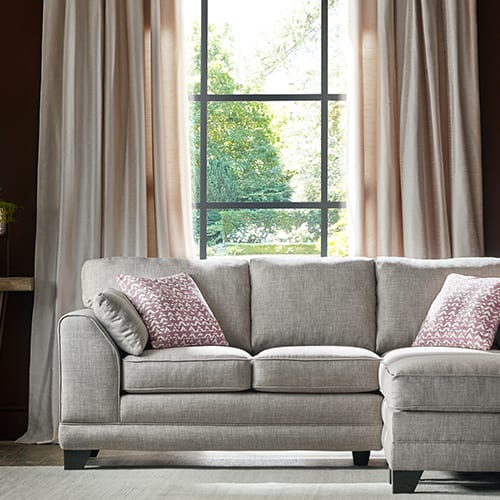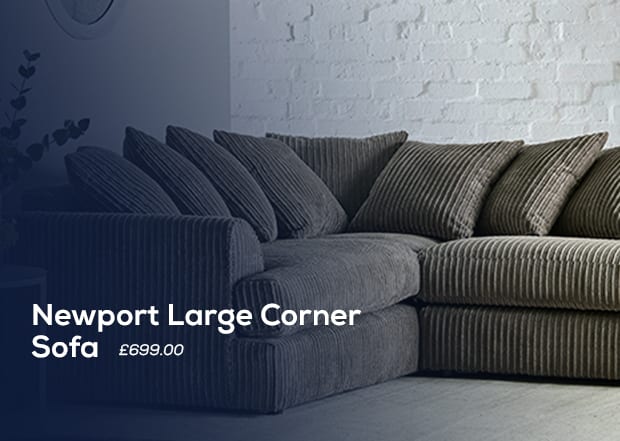How To Clean A Sofa
Your sofa is the heart of your home. It’s where you go to relax and destress – so of course, you want to make sure that your comfort isn’t ruined by any nasty stains or smells. However, despite the fact that we likely spend time on our sofas at least once a day, how often do we really think about cleaning them?
So, whether you’ve finally given in and decided to do a general, overall clean, or you’ve come across a stubborn stain, we’ve provided everything you need to know in this handy guide about how to clean your sofa.
Table of Contents
What to Know Before You Clean A Sofa
Before you clean a sofa there are a few important things to consider in order to choose the best cleaning method and to ensure the material doesn’t become damaged or discoloured:
Always Read The Manufacturer’s Instructions

The best advice we can give on how to clean a sofa or upholstered chair is to read the instructions provided by the manufacturer. You will likely find these in any brochures or leaflets that came with your sofa when it was delivered, or on the manufacturer’s website.
The manufacturer will know the most about your sofa – so it’s always best to trust the information they provide.
Check Sofa Labels
If you’re unable to find any clear information from a manufacturer, there will usually be a label somewhere on your sofa with cleaning instructions.
You should lookout for the following markers:
- ‘W’ – Able to be washed with water for spot cleans, however do not put any fabric in the washing machine unless specified.
- ‘S’ – Not able to be cleaned with water. Use a solvent-based cleaning solution or dry clean.
- ‘SW’ – Able to be cleaned with water-based and solvent-based cleaners, as well as dry cleaning methods.
- ‘X’ – Only use a vacuum cleaner or dry brush.
Spot Test Your Cleaning Solution

Before you start to clean a sofa, you should make sure to test any product or method on a small, inconspicuous area of the material. This will help you to make sure you’re not doing anything to damage the sofa fabric – and if you do make a mistake, at least this happened in an area you’re not likely to notice.
With a spot test, you should be making sure that your cleaning solution is appropriate, but also that your cloth or brush doesn’t cause any damage. For example, some cloths have dye that can transfer once they become wet or are being rubbed. You should also always wait for your spot test method to fully dry before being confident that you can use it to clean the rest of the sofa.
Work Out The Material

Firstly, you’ll need to find out what type of material your sofa is made of in order to work out the best way to clean it. This is because some materials are better suited to certain cleaning methods than others.
For fabric sofas, you should bear in mind that you won’t be able to use water-based cleaners on some materials made from organic fibres including:
- Cotton.
- Rayon.
- Silk.
You should also bear in mind that if your sofa is made up of synthetic fabric, it will have a much lower melting point than organic material. Therefore, they won’t be suited to steam cleaning. Alternatively, if your sofa is non-fabric and is made of a material such as leather, this will come with its own recommended cleaning products.
As we’ve already mentioned, be sure to check the manufacturer’s instructions and any labels on your sofa if you’re in any doubt about the type of fabric or the most appropriate cleaning method.
How To Clean A Sofa Based On The Type Of Spill

Once you’ve determined what material you’re working with, the best way to clean a sofa will depend on the type of spill or stain, as well as whether you’re looking for a surface clean or something deeper.
Our best advice for each type of stain includes:
Pre-Cleaning With A Vacuum
You should always start by removing any crumbs, dust or debris from your sofa before you clean it more deeply. You can do this by vacuuming the fabric of your sofa as well as underneath the cushions, or using a lint roller such as this self-cleaning model from Good Grips.
If your sofa is made of leather, this is the main way that you’ll need to clean it. You shouldn’t use fabric cleaners on a leather sofa as they are not suited for this material.
Cleaning Water Spills By Blotting
The best thing you can do if water has spilt on your sofa is to blot it immediately with a dry, non-dyed, clean cloth or kitchen paper towel. You should also remove any covers to blot the cushion underneath in order to make sure you’ve soaked up all of the damp. Make sure to push down firmly and keep blotting until the material is dry.
Additionally, you can use a handheld hair dryer on the cool setting or a fan to gently dry any water spills. However, you should never use hot air on your sofa. In addition, make sure not to hold the hairdryer too close to the fabric to avoid causing any damage.
To remove water stains from a sofa, try sprinkling dry baking soda over the stain, patting this in and leaving it to dry before hoovering.
Cleaning Grease With Dish Soap
For any greasy, oily spills, you should use an anti-grease cleaner. You can purchase a solution specifically for this purpose, or you can make one yourself using a small amount of clear dish soap mixed with some warm water. Gently pat and blot this solution into the stain making sure to use a dye-free cloth to avoid further staining.
However, make sure to check that your sofa is compatible with water-based cleaners. Otherwise, you’ll need to use a solvent-based product.
Removing Dark Stains With Baking Soda And White Vinegar
For stubborn stains such as coffee, red wine or tea, you can use a homemade stain remover by creating a solution of baking soda and white vinegar.
Simply combine a tablespoon of baking soda, a few drops of white vinegar and enough water to make a paste. Then work this gently into the stain with a cloth. Leave this to sit for 10 mins and then use a cloth with warm water to wipe away the paste.
You can even add a tiny amount of washing up liquid if the stain you need to remove is greasy or fatty – for example, if you’ve spilt a coffee that has milk in it or for makeup stains.
Alternatively, you can purchase upholstery stain remover such as Vanish Oxy Action. This is an extra-strength stain remover that works well for old, dried-in stains.
Deep Cleaning A Fabric Sofa With A Steam Cleaner
If your sofa is able to be cleaned with water, you should give your entire sofa a deep clean at least once a year to keep it in top condition. Steam cleaning uses high temperatures to remove stubborn stains, and when combined with a detergent or conditioner, will give your sofa a good, overall clean to remove stains and odours.
In order to steam clean a fabric sofa, you should:
- Use a fabric detergent suitable for your sofa.
- Make a solution of detergent and water (use the guidelines on your chosen fabric detergent for quantities.)
- Pour the solution into the tank of your steam cleaner, making sure to securely fasten the cap and using any locking mechanisms.
- Apply the shampoo to the sofa using the upholstery attachment making sure to move slowly and cover everything evenly.
- Use the ‘suction’ function on your steam cleaner to slowly remove excess detergent from the sofa.
- Make sure to replace the water as you go if it becomes too dirty.
- Allow your sofa to air dry.
However, you should bear in mind that a steam cleaner can be difficult to use on your own. It’s also expensive to buy the equipment needed to do this. So, we recommend getting a professional to do any steam cleaning for you.
How To Clean A Fabric Sofa Without Water
If your sofa is made from natural material such as cotton or silk, or if its label has an ‘S,’ this means that you shouldn’t use water to clean it. Using water on this type of material will cause the fabrics to swell and become damaged.
So, to clean a sofa made from organic materials, you’ll need to use a dry-cleaning method. Start by prepping your sofa as you would any other way: by using a vacuum, a brush and a lint roller to remove any crumbs, dust and pet hair.
Then, use a solvent-based cleaner such as World of Clean Dry Cleaning Solvent to remove stains and spots. These types of cleaners are still liquid; however, they do not contain any water which can damage sofas with natural fibres.
In order to tell that the cleaner you’ve bought is definitely solvent-based, check the ingredients and look out for things like ‘isopropyl alcohol,’ ‘glycerin’ or ‘propylene glycol.’ If you see ‘water’ as one of the ingredients, you won’t be able to use these on many natural fabrics.
Cleaning A Leather Sofa

If you want to clean a sofa made of leather, you won’t be able to use fabric cleaners or detergents without risking damage to the material.
Instead, you should clean leather by:
- Wiping down the surface with a brush or lint roller and hoovering any dirt.
- Use a purpose-built leather conditioner to prevent general wear and tear.
- Gently rubbing olive oil into any scuffs with a cloth or a cotton bud.
- Using a leather stainer such as Furniture Clinic’s Leather Recolouring Balm to buff any faded or discoloured leather back to life.
Most faux leather sofas use the same cleaning methods as their leather counterparts,
How To Remove Odours From Upholstery
If you want your sofa to stay clean and fresh, you’ll need to do more than simply clean a sofas surface. In order to remove odours from upholstery you should use:
Baking Powder
A benefit of using baking powder to remove odours from a sofa is that this is a natural cleaning method. Many chemical deodorisers can cause damage to the environment and can also lead to allergy flare-ups for those who are sensitive to allergens.
You should remove any cushions from their covers and sprinkle baking soda across every part of the sofa. You can also use a brush to make sure the baking soda penetrates the fibres. Leave this to sit for ten minutes and then hoover everything with a vacuum cleaner.
Deodoriser Sprays
Alternatively, you can use a fabric deodoriser to remove stubborn smells from any upholstery. We recommend anything in the Febreze fabric odour range. They sell a variety of options for dark and light fabrics, offer scent-free ranges for those with allergies as well as offering anti-microbial products for extra cleanliness.
You should always make sure to choose a spray labelled as an ‘odour eliminator’ rather than an ‘odour remover.’ This is because the former actually works to get rid of any nasty smells from the source rather than simply covering them up with a pleasant aroma like the latter.
Time To Get Cleaning

Now you know all the best ways to clean a sofa, it’s time to get cleaning! We’ve recommended the best homemade cleaning solutions as well as some of the best-branded products to keep your upholstery looking great and smelling fresh.
Just make sure to always check the manufacturer’s instructions to clean a sofa, look out for any cleaning labels and always test anything on a small, inconspicuous area of any sofas to make sure you don’t cause damage or discolouration.











